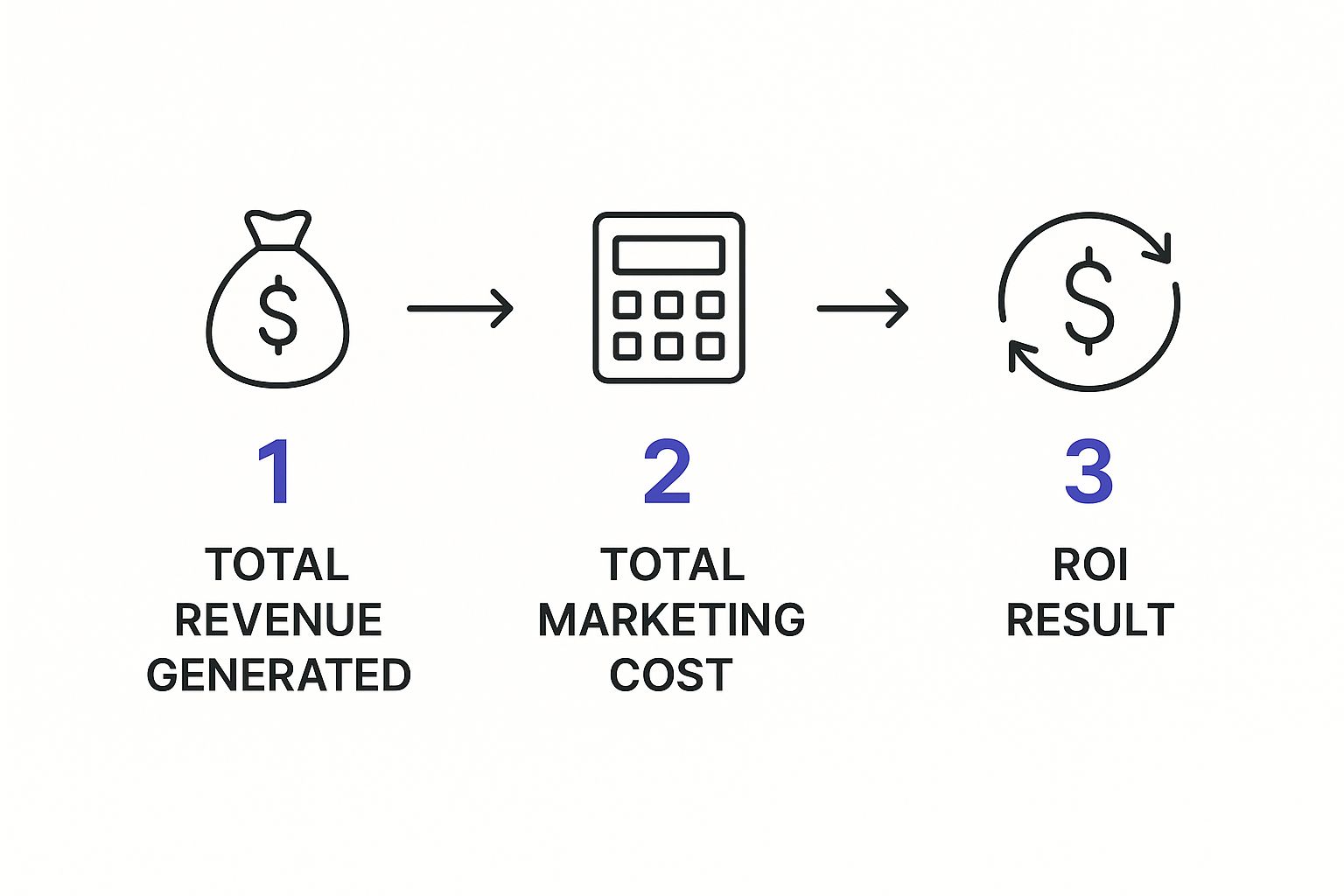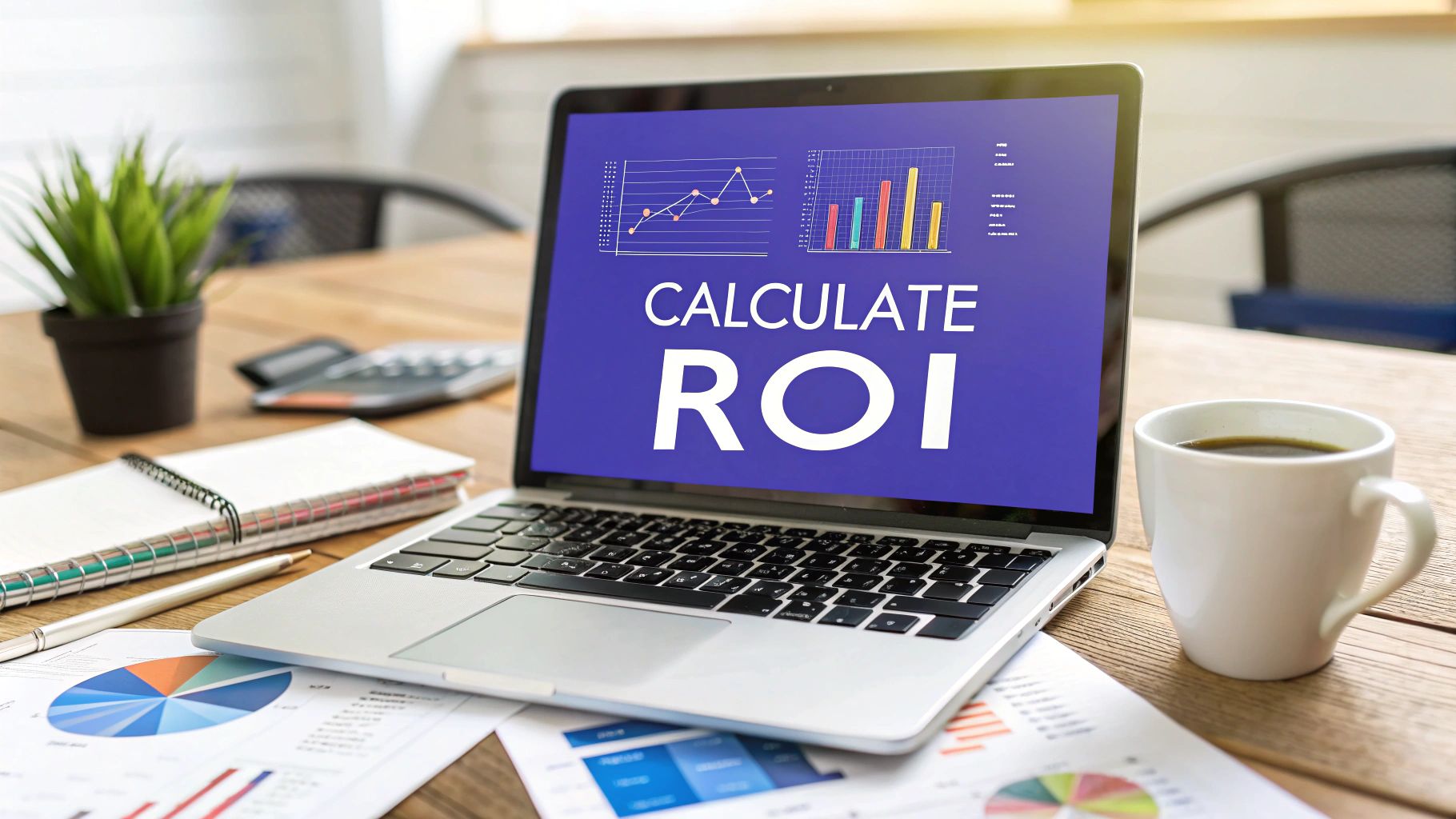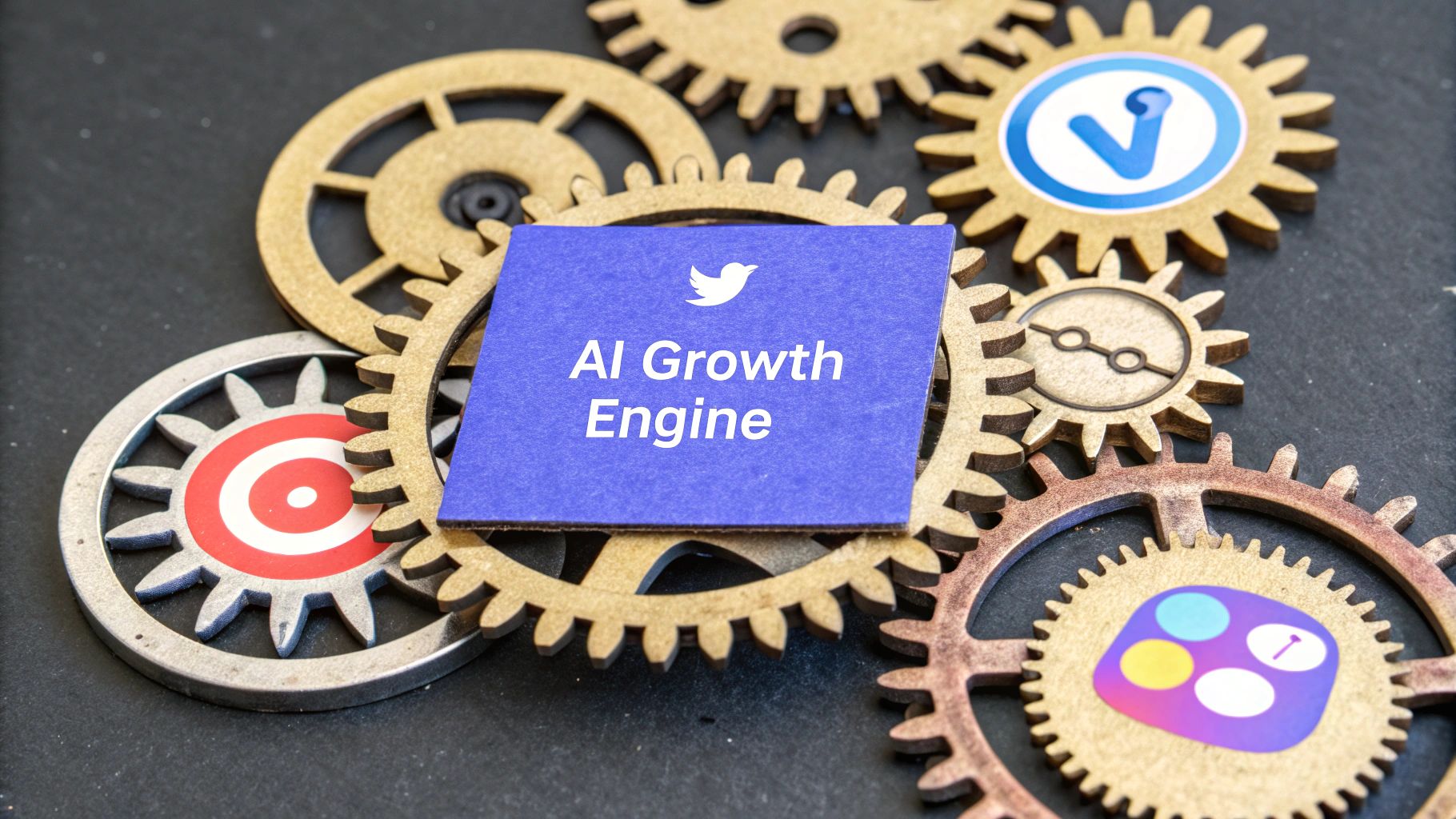To figure out your marketing ROI, the math is actually pretty simple. You take the revenue a campaign generated, subtract what you spent on it, divide that number by the cost, and then multiply by 100.
This gives you a straightforward percentage. Think of it like this: ((Revenue - Cost) / Cost) x 100. It's the cleanest way to see what you got back for every dollar you put in.
Why Marketing ROI Matters
Before you even open a spreadsheet, it’s worth asking why we obsess over this number. Honestly, it’s the difference between guessing and knowing. Calculating your marketing ROI is how you prove your worth to the higher-ups, fight for a bigger budget, and get smart about where your money is going.
Without it, you're just throwing things at the wall and hoping something sticks. You can't tell which campaigns are actually driving growth and which ones are just an expensive hobby.
The Core Formula Explained
At its heart, the process is pretty universal. The classic formula you'll see everywhere is: ROI (%) = ((Revenue from marketing - Marketing costs) / Marketing costs) × 100.
It’s the standard for a reason—it quickly tells you how efficient your spending was.
For example, say you run a campaign that brings in $50,000 in new sales, and you spent $10,000 to make it happen. The ROI would be ((50,000 - 10,000) / 10,000) × 100, which equals a 400% return. For more examples, check out this guide on the fundamentals of ROI calculation on diggrowth.com.

Breaking Down the Components
To make this formula work for you, you have to get granular with the two main inputs.
- Revenue from Marketing: This is the total sales revenue you can directly tie back to a specific marketing campaign. Let's be real, this is often the hardest part to track accurately.
- Marketing Costs: This is everything you spent. It includes the obvious stuff like ad spend, but also software tools, agency fees, and even a portion of your team's salaries.
To illustrate how these inputs come together, here's a simple breakdown for a hypothetical digital ad campaign.
Sample Marketing ROI Calculation Breakdown
| Metric | Description | Example Value |
|---|---|---|
| Revenue from Marketing | The total sales directly generated by the campaign. | $15,000 |
| Marketing Costs | The sum of all expenses incurred for the campaign. | $3,000 |
| Marketing ROI Formula | ((Revenue - Cost) / Cost) x 100 |
(($15,000 - $3,000) / $3,000) x 100 |
| Calculated ROI | The final percentage representing the return. | 400% |
This table shows that for every $1 invested, the campaign generated $4 in profit, resulting in a 400% ROI. It's a clear, quantifiable measure of success.
The goal isn't just to get a number; it's to get an accurate number. A precise ROI calculation is your best tool for optimizing future campaigns, ensuring every dollar you spend works as hard as possible to grow the business.
Gathering the Right Data for an Accurate ROI
Any ROI calculation is only as good as the data you feed it. To get a real, honest number, you have to look past the surface-level metrics and get your hands dirty with the specifics of both your revenue and your costs. Your CRM or e-commerce platform—think Shopify—is usually the best place to start pulling sales data.
But that's just half the story.
The real trick is nailing down your total marketing investment. It’s a snap to count up your ad spend, but what about all the other expenses that quietly add up in the background? It's easy to overlook these, but they're crucial.
These often include things like:
- Software Subscriptions: All those analytics tools, content schedulers, and design platforms.
- Agency or Freelancer Fees: The cost of any outside help you brought in for the campaign.
- Prorated Team Salaries: A portion of your in-house team’s wages for the time they spent on the project.
If you skip over these costs, you’ll end up with an inflated ROI that looks great on paper but doesn't reflect reality. It gives you a dangerously misleading picture of your campaign's actual performance.
Attributing Sales to Marketing Efforts
Connecting a specific sale directly back to a marketing action is where the magic—and the difficulty—lies. This is where attribution models become so important. A first-touch attribution model gives 100% of the credit to the very first marketing channel a customer interacted with. On the other hand, a multi-touch model spreads that credit across several different touchpoints along the customer's journey. Picking the right model is key to understanding which channels are truly pulling their weight.
Honestly, this is where a lot of businesses get stuck. Their data is a mess, or they're just tracking the wrong things. A critical first step is understanding the importance of setting and measuring Key Performance Indicators (KPIs). As marketing analytics get more sophisticated, you really need to blend both qualitative and quantitative data into your ROI formula.
This visual from Salesforce breaks down the core pieces you need for a solid measurement strategy.

It perfectly illustrates that defining your goals and tracking down all the associated costs are the foundational steps you have to take before you even think about plugging numbers into a formula. And if you want to get into the nitty-gritty of channel-specific math, you might want to check out our guide on how to measure social media ROI.
Key Takeaway: Your final ROI figure is a direct reflection of your data's integrity. Take the time to meticulously track every cost and attribute every sale to ensure your calculations are accurate and defensible.
Putting the ROI Formula into Practice
Knowing the formula is one thing, but applying it correctly is where the real skill comes in. I’ve seen it time and time again: a one-size-fits-all approach to ROI almost always gives you a misleading answer. The context of your campaign completely changes how you should be running the numbers.
Let's walk through two very different, real-world scenarios.
A B2B Content Marketing Play
Imagine a B2B company that spends $20,000 over three months creating a series of in-depth whitepapers and webinars. Their goal isn't to get immediate sales; it's about generating high-quality leads for a sales team that has a six-month sales cycle.
In this case, success is all about long-term value. Instead of just looking at the revenue from a customer's first purchase, you absolutely have to use Customer Lifetime Value (CLV).
If that campaign generates 10 new clients, and each one has a CLV of $15,000, the total revenue you can attribute to the effort is $150,000. Do the math, and you get a healthy ROI of 650%. Not bad for a long-term investment.
A Fast-Paced B2C Flash Sale
Now, let's pivot to a completely different world: a B2C e-commerce brand running a one-week flash sale. They spend $5,000 on Instagram ads to drive immediate traffic. Here, the sales cycle is almost nonexistent—customers either buy right away, or they don't.
The campaign directly pulls in $18,000 in sales. The ROI calculation is much more straightforward because you're focused on immediate revenue. The return on this short-term push is 260%. This kind of quick feedback loop is perfect for rapid-fire testing and optimization.
This simple infographic breaks down the core calculation process that works for both scenarios.

It really just boils down to tracking your revenue and costs to get that final ROI percentage—the universal language of marketing performance.
The key takeaway is that the core formula remains the same, but the variables you plug into it—especially revenue—must be adapted to fit the business model and campaign goals.
For B2B marketing, the calculations almost always have to account for these longer, more complex sales cycles. A common industry benchmark I often refer to is a 5:1 revenue-to-marketing spend ratio. This means for every dollar you invest, you should ideally be generating five dollars in revenue.
So, for a $150,000 marketing investment, the expectation would be to see $750,000 in attributed revenue. If you want to dive deeper into this, you can find more great insights on B2B marketing ROI on hockeystack.com.
Translating ROI into Smarter Marketing Decisions

Okay, you've crunched the numbers and you have an ROI percentage staring back at you. That’s the easy part. The real work—and the real value—starts now.
Knowing what to do with that number is how you build a winning strategy. That final figure isn’t just a grade on your marketing report card; it's a road map for making much, much smarter decisions with your budget.
So, is a 200% ROI a massive success or a bit of a letdown? Honestly, it depends entirely on your context. What’s considered a "good" ROI is shaped by your industry, your profit margins, and the specific goals you set for that campaign.
Setting Your Performance Benchmarks
To give your ROI figure any real meaning, you need something to compare it to. Without benchmarks, you're just flying blind.
- Industry Standards: You’ll often hear a 5:1 ratio (or a 500% ROI) thrown around as a solid goal. But that’s a very broad benchmark. A high-volume, low-margin e-commerce brand needs a completely different return than a B2B SaaS company with high-ticket contracts.
- Historical Performance: Honestly, your most important competitor is your past self. Always measure new campaign results against your previous efforts. This is how you spot trends and confirm you’re actually improving over time.
This kind of comparative analysis is where you go from just knowing how to calculate marketing ROI to truly understanding what the results are telling you.
Your ROI isn't just a metric to report up the chain; it's a diagnostic tool. Use it to figure out what’s working, what isn’t, and where your marketing dollars will make the biggest splash next quarter.
Using ROI to Allocate Your Budget
This is where ROI becomes your secret weapon for optimization. By calculating the return for each of your marketing channels, you can finally stop guessing and start making data-backed decisions about where to put your money.
Let's say you discover your email marketing campaigns are consistently delivering a whopping 700% ROI, while your paid social ads are hovering around 250%.
That data doesn't automatically mean you should kill your social media ads. But it's a massive flashing sign that shifting some of that social budget over to your email efforts could seriously accelerate growth.
Using a structured approach, like the one in this social media marketing plan template, helps you keep these channel-specific goals organized and track your performance much more effectively.
This process transforms budget allocation from a game of gut feelings into a repeatable, data-driven strategy. It’s how you justify your spending, prove your team's value, and continuously fine-tune your marketing machine for maximum impact.
Common Mistakes When Calculating Marketing ROI
Getting the marketing ROI formula right is one thing, but avoiding the common traps that can throw off your numbers is a whole other challenge. I've seen even seasoned marketers make simple errors that lead to a completely skewed picture of their campaign performance.
When your calculations are off, you end up making bad budget decisions and misinterpreting what's actually driving growth for your business.
Hidden Costs and Flawed Attribution
One of the most frequent mistakes is ignoring all the "soft" costs. It's easy to add up your direct ad spend, but what about the salary of the project manager or the hours your design team poured into creating the campaign assets? These are very real expenses, and leaving them out gives you an inflated, inaccurate ROI.
Another classic blunder is relying on a simplistic attribution model. Last-click attribution, which gives 100% of the credit to whatever a customer clicked right before converting, is the usual suspect. This model completely ignores all the hard work your top-of-funnel content did to warm that lead up in the first place.
Overlooking Long-Term Value
It’s also easy to get tunnel vision, focusing only on immediate sales while completely forgetting about the long-term value you're building. A great content marketing campaign might not drive a ton of sales this week, but it could be building brand authority and trust that pays off for years to come.
A focus on short-term ROI can cause you to defund your most valuable long-term assets. True performance measurement balances immediate wins with sustainable growth, ensuring you're building a brand, not just chasing clicks.
To keep these errors from creeping into your work and make sure your numbers are solid, here’s what you can do:
- Account for All Costs: Don't just track ad spend. Make a comprehensive list of every potential expense—salaries, software subscriptions, freelancer fees, you name it. A solid marketing resource management system is perfect for keeping track of these often-hidden costs.
- Adopt Multi-Touch Attribution: It’s time to move beyond last-click. Use a model that gives credit to the various touchpoints along the customer journey. This will give you a much more realistic and holistic view of which channels are actually performing.
- Track Leading Indicators: For those bigger brand-building campaigns, you need to look at proxy metrics. Keep an eye on things like branded search volume, direct traffic to your site, and social media engagement to get a real sense of their value.
Answering Your Toughest Marketing ROI Questions
Even after you nail down the formula, the real world throws curveballs. Getting truly comfortable with marketing ROI means knowing how to handle those tricky, specific situations that pop up. This is where we move past the theory and into confident, practical application.
Let's dig into some of the most common questions I hear from marketers when they first start measuring their return on investment.
How Often Should I Calculate Marketing ROI?
The right answer to this depends almost entirely on your sales cycle. There’s no magic, one-size-fits-all schedule, but your business model offers the biggest clue.
- Fast-Paced E-commerce: If you're running daily or weekly ad campaigns where customers buy quickly, calculating ROI weekly or even monthly makes a ton of sense. This lets you make fast adjustments and get the most out of your ad spend.
- Long-Cycle B2B: For businesses where a deal takes months to close, a quarterly ROI calculation is far more realistic. Measuring too often will just give you a skewed, incomplete picture because your campaigns need time to actually work their magic.
The goal is to measure often enough to be agile but to give your strategies enough breathing room to deliver results.
What Is a Good Marketing ROI?
Everyone wants that golden number, but the honest truth is that a "good" ROI is completely relative. While a 5:1 ratio—that’s a 500% ROI—is often thrown around as a great benchmark, it's definitely not a universal standard. Context is everything.
A retail business with razor-thin margins might need a 10:1 ratio just to turn a profit. On the flip side, a high-margin software-as-a-service (SaaS) company could be wildly successful with a 3:1 ratio.
Your most important benchmarks are your own past performance and the established standards in your specific industry. Always track your results against what you've done before to see if you're actually improving.
Your ROI isn't just a static number; it's a story about your performance over time. The most meaningful comparison is against your own historical data, as it shows true growth and improvement.
How Do I Measure ROI for Branding Campaigns?
This is the classic tough nut to crack. Branding efforts are famous for not leading directly to sales, which makes a simple ROI calculation feel impossible. For these top-of-funnel campaigns, you have to shift your focus from immediate revenue to what we call "proxy metrics"—indicators of brand health and influence.
Instead of trying to tie a branding campaign to a specific sale, start monitoring metrics like:
- Branded Search Volume: Are more people searching directly for your brand name? This is a huge signal of growing awareness.
- Direct Website Traffic: An uptick in visitors typing your URL straight into their browser shows your brand is becoming a known destination.
- Social Media Engagement: Look at the growth in mentions, shares, and follower counts. These are solid indicators that your brand is resonating with people.
From there, you can start to correlate a sustained lift in these areas with long-term sales growth. For example, if conversions from your direct traffic jump by 20% during a big branding push, you can confidently attribute a chunk of that revenue back to the campaign's impact. For a deeper dive, check out this detailed guide on how to measure marketing ROI for more advanced techniques.
Ready to turn your ROI insights into a streamlined social media strategy? PostSyncer provides all the tools you need to schedule content, analyze performance, and prove your marketing's value in one centralized platform. Start your free trial at https://postsyncer.com and see how data-driven decisions can transform your results.















